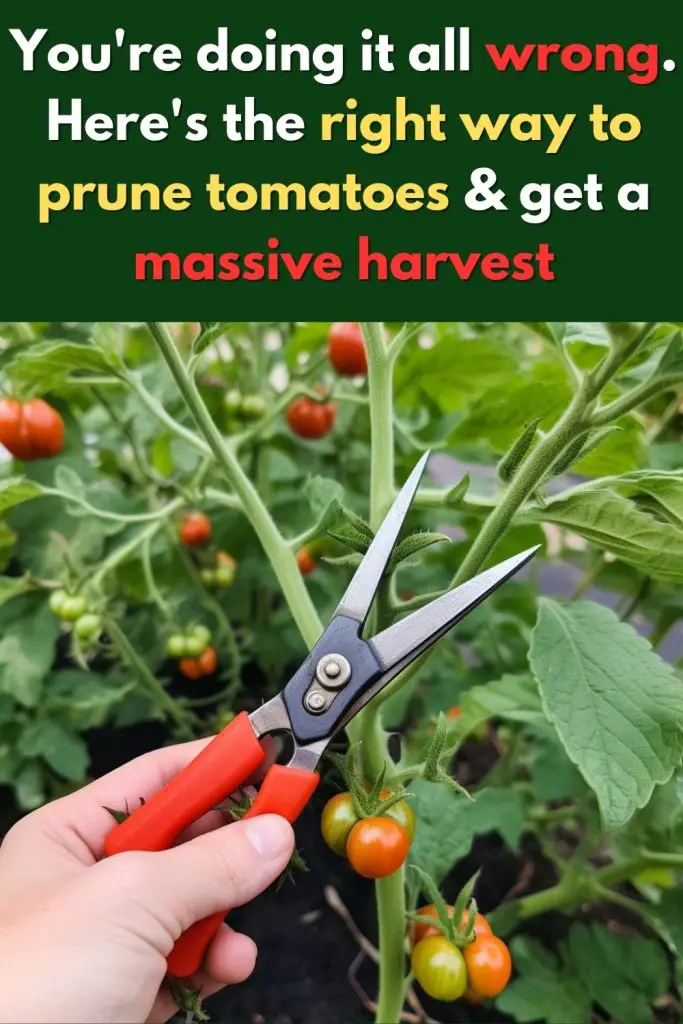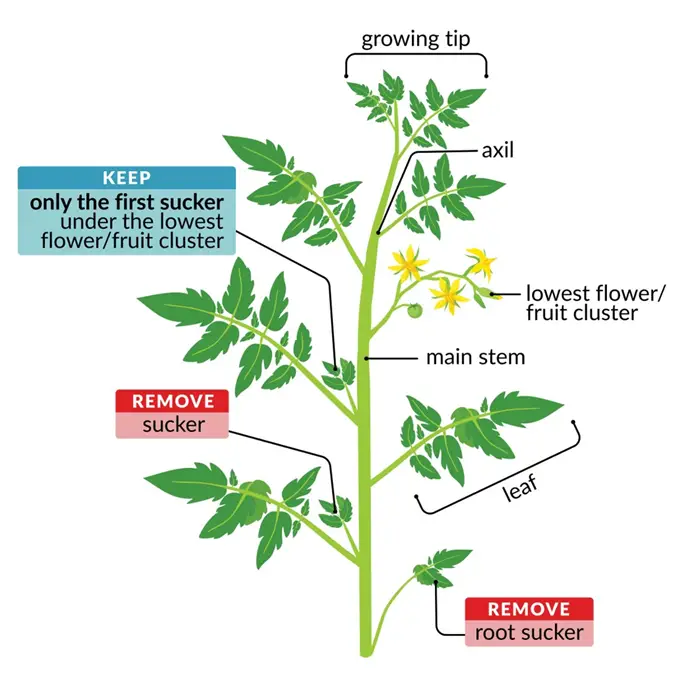Tomatoes are the jewels of the home garden – savory, versatile, and often the very reason many of us fall in love with gardening.
Yet, despite being quite resilient, they can be a bit high-maintenance if you’re aiming for peak performance. One practice often overlooked by novice tomato growers is pruning.
Pruning, when done right, can transform a manageable tomato plot into a thriving ecosystem of rich foliage and prolific fruiting.
But “right” is the operative word here, and the stakes (or should we say, “stakes”?) are too high to take chances.

This guide will walk you through the correct way to prune your tomato plants to guarantee a hefty harvest.
Understanding the Pruning Process
Pruning is more than just snipping off a few stray branches. It’s an art that involves understanding plant physiology and a bit of clairvoyance to foresee how your actions now will influence plant growth later.
Why Prune Your Tomato Plants?
Pruning your tomato plants may seem counterintuitive, especially if you’re new to gardening.
After all, why would you want to remove parts of the plant that are growing? The truth is that pruning your tomato plants can lead to a healthier, more productive crop.
Here are a few reasons why pruning is important:
- Increased air circulation: Pruning helps to open up the canopy of the plant, allowing for better air circulation. This can reduce the risk of diseases such as blight and mold, which thrive in warm, humid conditions.
- Larger, tastier fruit: By removing excess foliage, you can direct more energy into fruit production. This can result in larger, juicier tomatoes that are bursting with flavor.
- Better access to sunlight: Pruning allows sunlight to reach the lower parts of the plant, which can improve fruit ripening and overall plant health.
- Better Disease Control: Pruning allows for better visibility and access to the plant, making it easier to spot and remove diseased or damaged branches promptly. This proactive approach can help prevent the spread of diseases throughout the entire plant.
Now that you understand the benefits of pruning, let’s dive into the right way to prune your tomato plants for a massive harvest.
When to Prune Tomatoes
The timing of pruning is crucial for the success of your tomato plants. You’ll want to start pruning once your plants have established a few sets of true leaves and are starting to develop flower clusters.
This is typically around 4-6 weeks after transplanting your seedlings into the garden.
Tools You’ll Need
Before you begin your tomato pruning endeavor, it’s essential to arm yourself with the right tools. Here’s a list of must-haves:
- Pruning Shears: Essential for clean cuts on stems and branches.
- Tomato Stakes or Cage: Necessary for supporting the remaining main stems after pruning.
- Gloves: Protect your hands from possible irritants and sharp edges of branches.
- Antiseptic Solution: To dip your shears in between cuts, especially when dealing with diseased plants.
Step-by-Step Guide to Pruning Tomatoes

While specific techniques may vary, the principles of proper tomato pruning remain consistent. Here’s a guide to take you from the early growth stages to a mature, productive plant:
Early Stage Pruning: Removing Suckers
The first step is to train your plants early. When tomato plants are young, they grow “suckers,” or additional stems that will also bear fruit. Here’s how to remove them:
- Identify the Suckers: Look for the small shoots that develop in the leaf axils, the joint where the branch meets the stem.
- Pinch Or Prune At The Base: Using your fingers or pruning shears, remove suckers while they’re still small to avoid causing stress to the plant.
- Tending to Indeterminate Varieties: For those plants that will grow indefinitely, leave one or two suckers to produce additional fruit. For determinate varieties, remove all suckers.
Mid-Stage Pruning: Limiting Fruit-Bearing Stems
As your tomato plant grows taller, the temptation will be to allow just a few more stems to bear fruit. However, too much fruit can lead to smaller, less flavorful harvests. It’s time to make some tough decisions:
- Assess The Number Of Branches: Eight to twelve fruit-bearing branches are optimal for many home gardeners. Determine which to keep based on size, strength, and fruit setting performance.
- Prune Weak Or Excessive Branches: Remove the branches that are struggling or are unlikely to produce quality fruit.
- Support The Remaining Branches: Use stakes or cages to keep the remaining stems from breaking under the weight of fruit.
Late-Stage Pruning: Removing Excessive Foliage
By now, your plant should be bearing fruit, but heavy foliage can still be a problem:
- Evaluate The Leaf Density: A good rule of thumb is to have about two-thirds of the plant’s foliage remaining.
- Remove Lower Leaves: These leaves are the least productive. Pruning them will redirect energy to the developing fruit and improve air circulation.
- Keep Upper Leaves Intact: They are the plant’s food factory. Ensure they get enough sunlight to continue the photosynthesis that feeds the fruit.
Tips For Pruning Different Tomato Varieties
Not all tomato plants should be pruned equally. Here’s a quick rundown of how to tailor your approach to the type of tomatoes you’re growing:
- Indeterminate Varieties: These vining plants can benefit from strategic pruning to control growth and improve fruit development.
- Determinate Varieties: Plants that grow to a predetermined size and bear their fruit all at once require minimal pruning. Focus on removing suckers to reduce crowding and disease.
- Dwarf Varieties: Because of their small size and bushy nature, they often don’t require as much pruning, except to remove diseased or damaged parts.
Common Mistakes to Avoid
Pruning mistakes can set your plants back or, in some cases, irreversibly damage them. Here are errors to sidestep:
- Over-Pruning: Removing too much foliage can stress plants, slow growth, and reduce yields.
- Pruning in Heat or Sun: High temperatures can cause plants to wilt quickly after pruning. The cooler morning hours are best.
- Using Dull Tools: Make clean, sharp cuts to minimize damage and the risk of disease.
Maximizing Harvest through Pruning
Proper pruning can lead to a more bountiful harvest. Here’s how it works:
- Larger Fruits: By concentrating plant energy, each fruit tends to be larger and more flavorful.
- More Yields: Improved airflow and better sunlight exposure usually lead to more fruit overall.
- Earlier Harvests: A more efficient plant can ripen fruit faster, extending the growing season and your time to enjoy fresh tomatoes.
FAQ Section
Readers often have numerous questions about this topic. Here are some common inquiries:
How do I know if I’m pruning too much?
Keep an eye on your plant’s overall health. If it starts to look weak, and you’ve been diligent in watering and care, consider if you’ve pruned too aggressively.
Is it necessary to prune determinate tomatoes?
While they can often do without extensive pruning, some light maintenance can still benefit determinate varieties. Focus on removing suckers primarily.
Can I use the pruned material for anything else?
Certainly! You can use the pruned branches as part of your compost, and in some cases, you might be able to propagate new plants from the clippings.
Conclusion
Pruning your tomato plants can be a gratifying part of gardening. It not only helps your tomatoes reach their full potential but can also be a therapeutic exercise, allowing you to connect with your plants and fine-tune their growth. Share your experiences with pruning tomatoes and the results you’ve achieved.
Don’t forget to join the conversation on social media and tag us with your #TomatoPruningJourney.
Happy pruning, and even happier tomato-ing!